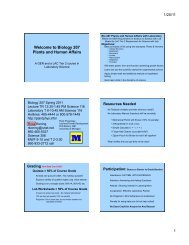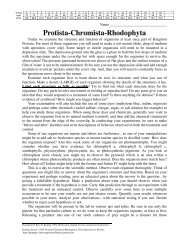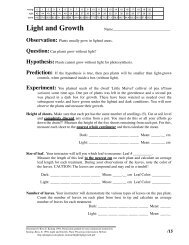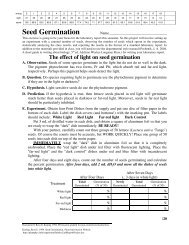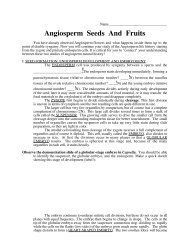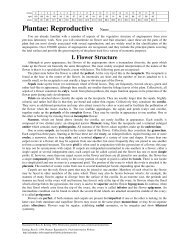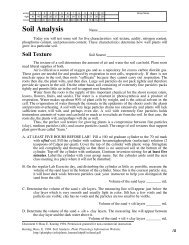Bee HyperAttractive - Home Page for Ross Koning
Bee HyperAttractive - Home Page for Ross Koning
Bee HyperAttractive - Home Page for Ross Koning
Create successful ePaper yourself
Turn your PDF publications into a flip-book with our unique Google optimized e-Paper software.
wrong 0 1 2 3 4 5 6 7 8 9 10 11 12 13 14 15 16 17 18<br />
right 109 108 107 106 105 104 103 102 101 100 99 98 97 96 95 94 93 92 91<br />
score 100 99.1 98.2 97.2 96.3 95.4 94.5 93.6 92.7 91.7 90.8 89.9 89 88.1 87.2 86.2 85.3 84.4 83.5<br />
<strong>Bee</strong> <strong>HyperAttractive</strong><br />
Name ____________________________<br />
You should have read the in<strong>for</strong>mation about honeybee biology from the website be<strong>for</strong>e coming<br />
to class. This is a computer exercise in pollination biology. Why computers in biology? <strong>Bee</strong>s are<br />
very dangerous to handle...it could be fatal <strong>for</strong> some of you! Computer bees are harmless “bugs.”<br />
Moreover, we can vary the computer flowers without having a huge collection of expensive real<br />
flowers on hand...all at the perfect stage of readiness <strong>for</strong> pollination! Also, we can do the project in<br />
a time interval less than a whole research career. The results given by the computer are consistent<br />
with those that have been obtained tediously in the field over a very long period of time.<br />
You will design the specifications <strong>for</strong> flowers and present them to a bee. The bee will visit each<br />
flower a certain number of times based upon how attractive you have made the flower and upon the<br />
temperature you have set. You will record the temperature, the characteristics of each flower and the<br />
number of visits to each flower. It is OK to use ditto marks or draw arrows <strong>for</strong> repetitive<br />
entries. Your goal is to be able to answer the questions using the data you have collected.<br />
The Effect of Color<br />
Set the temperature to 20°C. Be sure all the other variables are "none." Try all the colors <strong>for</strong> the<br />
flowers:<br />
20°C Color Odor Nectar Pollen #Visits<br />
Flower 1 none none none<br />
Flower 2 none none none<br />
Flower 3 none none none<br />
Flower 4 none none none<br />
Flower 5 none none none<br />
What is the most attractive color of flower? red yellow white blue purple<br />
What is the least attractive color of flower? red yellow white blue purple<br />
Repeat the trials at the other two possible temperatures.<br />
30°C Color Odor Nectar Pollen #Visits<br />
Flower 1 none none none<br />
Flower 2 none none none<br />
Flower 3 none none none<br />
Flower 4 none none none<br />
Flower 5 none none none<br />
Document © <strong>Ross</strong> E. <strong>Koning</strong> 1994. Permission granted <strong>for</strong> non-commercial instruction.<br />
<strong>Koning</strong>, <strong>Ross</strong>. E. 1994. <strong>Bee</strong> <strong>HyperAttractive</strong>. Plant Physiology In<strong>for</strong>mation Website.<br />
http://plantphys.info/plants_human/labpdf/beehyper.pdf<br />
/12
<strong>Page</strong> 2<br />
10°C Color Odor Nectar Pollen #Visits<br />
Flower 1 none none none<br />
Flower 2 none none none<br />
Flower 3 none none none<br />
Flower 4 none none none<br />
Flower 5 none none none<br />
Notice which colors are now the favorites and which are now the least preferred.<br />
Do bees change their color preferences as temperature is increased? yes no<br />
Why are bees attracted to certain colors?<br />
Honeybee vision allows a bee to see colors from __________ to __________ in the human<br />
visible spectrum.<br />
Why are bees not attracted to certain other colors?<br />
Honeybees cannot see our color __________ because it is outside of the bee's visible<br />
spectrum.<br />
The Effect of Fragrance<br />
Set all the flowers to the best color.<br />
Then, holding all other variables the same, change the fragrance:<br />
20°C Color Odor Nectar Pollen #Visits<br />
Flower 1 none none<br />
Flower 2 “ none none<br />
Flower 3 “ none none<br />
Flower 4 “ none none<br />
Flower 5 “ none none<br />
What is the most attractive fragrance? sweet spicy acrid fetid<br />
What is the least attractive fragrance? sweet spicy acrid fetid<br />
/17
<strong>Page</strong> 3<br />
Repeat the trials at the other two possible temperatures:<br />
30°C Color Odor Nectar Pollen #Visits<br />
Flower 1 none none<br />
Flower 2 “ none none<br />
Flower 3 “ none none<br />
Flower 4 “ none none<br />
Flower 5 “ none none<br />
10°C Color Odor Nectar Pollen #Visits<br />
Flower 1 none none<br />
Flower 2 “ none none<br />
Flower 3 “ none none<br />
Flower 4 “ none none<br />
Flower 5 “ none none<br />
Notice which fragrances are now the favorites and which are now the least preferred.<br />
Do bees change their fragrance preferences as temperature is increased? yes no<br />
Check over your past experiments to answer these three questions:<br />
If a flower is the wrong color and produces no fragrance, will a bee visit at all? yes<br />
If a flower produces neither a nectar nor pollen reward, will a bee visit at all? yes no<br />
Will the bee make a return visit to such a flower? yes no<br />
The Effect of Nectar<br />
Set all the flowers to the best fragrance as well as the best color.<br />
Then, holding all other variables the same, vary the nectar:<br />
20°C Color Odor Nectar Pollen #Visits<br />
Flower 1<br />
none<br />
Flower 2 “ “ none<br />
Flower 3 “ “ none<br />
Flower 4 “ “ none<br />
Flower 5 “ “ none<br />
no<br />
/20
<strong>Page</strong> 4<br />
30°C Color Odor Nectar Pollen #Visits<br />
Flower 1<br />
none<br />
Flower 2 “ “ none<br />
Flower 3 “ “ none<br />
Flower 4 “ “ none<br />
Flower 5 “ “ none<br />
10°C Color Odor Nectar Pollen #Visits<br />
Flower 1<br />
none<br />
Flower 2 “ “ none<br />
Flower 3 “ “ none<br />
Flower 4 “ “ none<br />
Flower 5 “ “ none<br />
What is the most preferred nectar at 30 degrees? watery sweet sugary bitter<br />
What is the most preferred nectar at 20 degrees? watery sweet sugary bitter<br />
What is the most preferred nectar at 10 degrees? watery sweet sugary bitter<br />
What nectar is least preferred? watery sweet sugary bitter<br />
Why do bees prefer the quality of nectar observed to be best at 10 degrees?<br />
At 10° C a honeybee needs more __________ to replace what is used when the honeybee<br />
__________ her ____________________ without moving her __________ which<br />
generates body heat.<br />
Why do bees prefer the quality of nectar observed to be best at 30 degrees?<br />
At 30° C a honeybee needs more __________ to replace what is used when the honeybee<br />
__________ her ____________________ <strong>for</strong> evaporative cooling.<br />
/21
<strong>Page</strong> 5<br />
The Effect of Pollen<br />
Leave the flowers at the best color and fragrance. Set the temperature to 20 degrees. Set the<br />
nectar to its best state <strong>for</strong> 20 degrees. Then, change the pollen type:<br />
20°C Color Odor Nectar Pollen #Visits<br />
Flower 1<br />
Flower 2 “ “ “<br />
Flower 3 “ “ “<br />
Flower 4 “ “ “<br />
Flower 5 “ “ “<br />
Set the temperature to 30 degrees. Set the nectar to its best state <strong>for</strong> 30 degrees. Repeat…<br />
30°C Color Odor Nectar Pollen #Visits<br />
Flower 1<br />
Flower 2 “ “ “<br />
Flower 3 “ “ “<br />
Flower 4 “ “ “<br />
Flower 5 “ “ “<br />
Set the temperature to 10 degrees. Set the nectar to its best state <strong>for</strong> 10 degrees. Repeat…<br />
10°C Color Odor Nectar Pollen #Visits<br />
Flower 1<br />
Flower 2 “ “ “<br />
Flower 3 “ “ “<br />
Flower 4 “ “ “<br />
Flower 5 “ “ “<br />
What is the preferred pollen at all these temperatures? dry clumped sticky wet<br />
The least preferred pollen at 10°C is __________, and it is more acceptable at ______°C<br />
because the honeybee needs more __________ to replace what is used when she<br />
___________ her ____________________ <strong>for</strong> evaporative cooling.<br />
/24
<strong>Page</strong> 6<br />
What are the Optimum Flower Characteristics?<br />
Check through your projects so far to answer these three questions:<br />
What is the optimal combination of flower characteristics at 10 degrees?<br />
10°C Color Odor Nectar Pollen #Visits<br />
Optimal<br />
Flower<br />
What is the optimal combination of flower characteristics at 20 degrees?<br />
20°C Color Odor Nectar Pollen #Visits<br />
Optimal<br />
Flower<br />
What is the optimal combination of flower characteristics at 30 degrees?<br />
30°C Color Odor Nectar Pollen #Visits<br />
Optimal<br />
Flower<br />
/15



